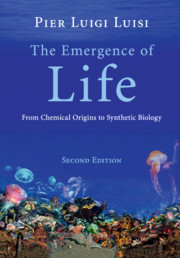Book contents
- Frontmatter
- Contents
- Acknowledgments
- Introduction
- Part I Approaches to the origin of life
- Part II What is life? The bio-logics of cellular life
- Part III Order and organization in biological systems
- Part IV The world of vesicles
- Part V Towards the synthetic biology of minimal cells
- As a way of conclusion
- Appendix The open questions about the origin of life
- References
- Names index
- Subject index
Introduction
Published online by Cambridge University Press: 05 September 2016
- Frontmatter
- Contents
- Acknowledgments
- Introduction
- Part I Approaches to the origin of life
- Part II What is life? The bio-logics of cellular life
- Part III Order and organization in biological systems
- Part IV The world of vesicles
- Part V Towards the synthetic biology of minimal cells
- As a way of conclusion
- Appendix The open questions about the origin of life
- References
- Names index
- Subject index
Summary
The first edition of this book, published in 2006, was written about 10 years ago; a partial update was done in the Japanese edition, in the 2010 Spanish edition, and in the 2013 Portuguese edition. A more complete English update was deemed necessary. Not that something dramatic has taken place since the first edition: the origin of life remains an unsolved question. At the last 2004 ISSOL meeting in Nara, Japan, a discussion took place on the question “what is life?,” and this was conducted in similar terms and emphasis as the conversation 20 or 30 years back. Of course, in all these years, although not solving the core question, some particularly important research papers have appeared, and the corresponding update will be presented, to the best of my knowledge, in this second edition. However, this is not the main reason for this second edition.
Life on Earth is based on ordered sequences of proteins and nucleic acids, and on their mutual ordered interactions. And the solution to the quest for the origin of life is the answer to the question, of how this order came about. There are approaches to the origin of life that ignore this simple consideration and start from already pre-constituted ordered systems. This is the case of the (original) RNA-world, starting from a self-replicating RNA. This is a highly ordered, functional macromolecule, and to explain the origin of life from this ordered state would be akin to constructing a house roof first. The same can be said for those researchers who advocate viroids, or pristine forms of ribosomes, as the starting base to explain the origin of life. First, you should explain how this highly ordered state came about – and if you do so, perhaps, yes, you then have paved the way to explain the origin of life. To be clear on that: the research on the three areas mentioned above is often of the highest quality, and corresponds to the best pages of modern science. But in my view it will help very little to explain the origin of life on Earth.
The other approach to the origin of life starts from the opposite direction, namely from the disorder of monomers or low molecular weight compounds. The keywords here are hydrothermal sources, marine or volcanic smokes, endogenous prebiotic molecules, or molecules coming from space.
- Type
- Chapter
- Information
- The Emergence of LifeFrom Chemical Origins to Synthetic Biology, pp. xii - xivPublisher: Cambridge University PressPrint publication year: 2016



